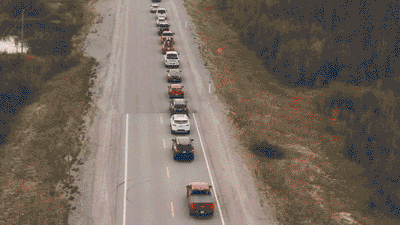
CONSIDER THIS SUMMER YOUR CLIMATE EMERGENCY ANNOUCEMENT
It’s really here and you are on your own
Summer 2023 was the hottest month planet wide in 120,000 years
This is the hottest summer endured by human civilization, but the context is even more alarming. In a nutshell, during the La Nina cycle that just ended, the planet recorded the eight hottest years on record. But La Nina is associated with a cooling cycle. With El Nino just beginning, there is really no telling what will transpire.

Salt water entering New Orleans water supply
Emergency declaration as extended drought pushes salt water into Mississippi River estuary
Both the state of Louisiana and the City of New Orleans have issued emergence declarations as the city that should not be there acknowledged the threat to its drinking water supply. Saltwater from the Gulf is entering the river due to drought-driven low water levels.
For those who rely on the Mississippi River for drinking water, the saltwater intrusion is a potential health risk, as high concentrations of salt in drinking water may cause people to develop increased blood pressure and corrode drinking water infrastructure.

Halifax sees lethal flooding in “Biblical” event
10″ of rain in 24 hours kills four in “under the radar” disaster
Halifax and Nova Scotia did not make the news in August when an extreme storm smacked into the city and surrounding area, but the resulting flooding
“We need to understand that all of these things are pounding away at our infrastructure, at our roads and our culverts. So even though we get past one event, it might be a hurricane and then we have the fire and then we have the rain. They’re all taking an impact on infrastructure.”
Mike Savage, Halifax mayor. infrastructure, just like ourselves, is being pounded by cumulative weather events,’ Halifax mayor says.

September 2023 hottest ever
,

12,000+ Dead In Libyan Storm Onslaught
“People are using shovels to get the bodies from underneath the ground, they are using their own hands. They all say it’s like doomsday.”
A Mediterranean cyclone brought 16 inches of rain in 24 hours to eastern Libya, driving a ten foot tsunami wall that destroyed dams, bridges and infrastructure in the process of setting a new rainfall record. This is more than a year’s rainfall in a place so dry that no permanent river runs through it. Storm Daniel is a Medicane,, a term coined to describe the increasingly violent weather impacting the regions as the globe heats
Around 10,000 more are missing and 30,000 displaced in Derna, a city of 100,000. Many are believed swept out to sea or buried in rubble..

Antarctic Ice Melting Even Faster Than predicted.
The size of ice volume lost this year in Antarctica is about the area of Argentina
Antarctica is likely warming at almost twice the rate of the rest of the world and faster than climate change models are predicting, with potentially far-reaching implications for global sea level rise, according to a scientific study.
In West Antarctica, a region considered particularly vulnerable to warming with an ice sheet that could push up global sea levels by several metres if it collapsed, the study found warming at twice the rate suggested by climate models.
Climate scientists have long expected that polar regions would warm faster than the rest of the planet – a phenomenon known as polar amplification – and this has been seen in the Arctic.

Hurricane Lee Is A Record Breaking Monster

Irony of the Year: Fertile Crescent No Longer Fertile
“The Fresh Water is Finished”
The “cradle of civilization” is drying rapidly, driving inhabitants from their ancestral lands between the Tigris and Euphrates. Locals once lived self-sufficient lives in the Iraq Marshlands, making traditional livings fishing and herding Water Buffalo. The epicenter of the slo-mo disaster is the city of Basra, once known as the Venice of the East. About 40% of Iraq has already been overtaken by sand.

Canada Wildfires Move North As 20,000 Evacuated
With hundreds of wildfires already sweeping through BC and Quebec, Canada’s worst wildfire season just got worse as the disaster moves into the Northwest Territories. In Yellowknife, a mandatory evacuation order went into effect creating a chaotic scene as long lines of cars queued for miles to flee along the only road out of town.

Killer Sandstorm + All Time Record High For Morocco

Firestorms in Maui kill hundreds

Thwaites “Doomsday” Ice Shelf Melts From Below
Dubbed the Doomsday Glacier because of it’s potential to raise sea levels around the world very rapidly, the Thwaite’s ice shelf in West Antarctic is melting from below. Ice shelves are hybrid formations that float on land and help slow the flow of trillions of tons of land ice to the ocean.

Sri Lanka all time heat record August
Endless record heat in Sri Lanka with a new August record pulverized at Ratnapura today with 37.2C Record heat is also in the Philippines (Tmins >29C),Vietnam and Thailand In just 10 days of August about 1/3 of world countries broke heat records, while only Italy had low records.

Scary South America Winter Temps Setting Records
102°F is plenty hot any day most places, but it’s winter in South America and the town of Vicuna, Chile is roasting. And Vicuna is in the Andes Mountains. For perspective, think of August in South America as the equivalent of February in North America.
“South America is living one of the extreme events the world has ever seen,” weather historian Maximiliano Herrera tweeted, adding, “This event is rewriting all climatic books.”

Global emissions continue to climb
The most recent widely ignored warning from climate scientists would be worrisome if anyone was listening. Greenhouse gas emissions have reached an all-time high, threatening to push the world into “unprecedented” levels of global heating, scientists have warned. Levels of the big three greenhouse gases carbon dioxide (CO2), methane ( CH4) and nitrous oxide in the atmosphere, continued unprecedented rates of growth during 2022. CO2 alone increased by nearly 1%, driven in part by switchovers to goal as Russia squeezed the global supply of methane.

Under the radar killer dirt storm in Illinois
The storm came suddenly on a clear cool day and hit the travelers on interstate 55 near Springfield, IL by surprise. The 200 ft high wall of soil blinded drivers, turning the day into utter darkness and sending 84 speeding vehicles crashing into each other. Some caught fire and burned on the highway. The death toll was seven, with vehicles and bodies burned beyond recognition. This is a global warming event, driven by drought and unenlightened industrial ag practices.

Italy smashed by record heat, fires, floods & glacier collapse
The collapse of a glacier in the Dolomites and a landslide on the island of Ischia. Devastating floods, wildfires and record-breaking heatwaves. The worst drought of the Po, Italy’s longest river, in 200 years. Luca Mercalli, an Italian climatologist, has seen his fair share of extreme weather events in Italy within the past two years. But nothing prepared him for the scene in Mortegliano, a small town in Friuli-Venezia Giulia, the northern region bordering Slovenia.

Salt water incursion threatens açaí crop, Amazon
The climate emergency combined with industrial agriculture in coastal Amazonia are threatening açaí harvests in Brazil’s Macapa region. Soil erosion and the creep of seawater into the freshwater river are changing the berries’ flavor and tainting drinking water.
Seawater began pushing back the river around the delta island archipelago in late 2021, leaving thousands of residents without fresh water.

Record low ice levels in Antarctic winter ice melt
A sharp winter slowdown in Antarctic sea ice growth has added another slo mo catastrophe to the list of climate driven threats. Current levels show a shortfall that is radically rewriting the record books.
Speaking to the New York Times in early August, Ted Scambos (a senior research scientist at the University of Colorado Boulder) said: “This year is really different. It’s a very sudden change.”
When sea ice collapses, the trillions of tons of land ice behind it accelerates its flow into the Southern Ocean, raising seas planetwide. The sea ice also plays a role in regulating ocean and air temperatures, potentially affecting marine life from microscopic plankton to the continent’s iconic penguins.0